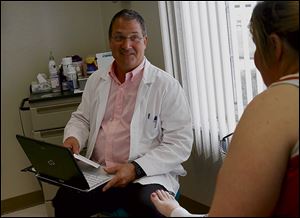
Sweet feet: Tips for foot safety
Wear alternating shoes to give foot muscles a workout
6/23/2014
Dr. Gregory Black examines a patient at his office in Sylvania. Dr. Black is a podiatrist who sees a large number of foot injuries and health issues.
THE BLADE/KATIE RAUSCH
Buy This Image

Dr. Gregory Black examines a patient at his office in Sylvania. Dr. Black is a podiatrist who sees a large number of foot injuries and health issues.
How often do you say, or do you hear someone else say, My feet are killing me?
It’s a common statement, and according to Sylvania podiatrist Dr. Gregory Black, among the common foot problems likely to evoke that remark are warts, fungus infections, plantar fasciitis — and that’s just for starters.
One of the best ways to treat your feet nicely is to change your shoes daily, Dr. Black said.
“We could have a whole different conversation about shoes,” he said. “You have to think of your foot as a structure that functions. There are muscles and joints in there. If you wear the same shoe all the time, your muscles will adapt and you will see changes. You want to work your muscles.”
If you wear a snug fitting shoe today, try a looser fitting one tomorrow. Wearing the same pair daily forces the muscles and joints to work the same way all the time. Alternating shoes lets the foot work and function differently. And try to go without shoes sometimes, too.
“If you can, go barefoot as much as possible on protective surfaces,” inside the house or in the yard where there’s nothing that could cause injury, he said. “Use your foot as much as possible in its natural state. There are people who are barefoot quite often around the world.”
And while the garment and shoe industries make consumers think they cannot live without their ready-to-wear. That includes women’s stilettos and everyone else’s flip flops. Though he said that “fashion will override function,” and that high heels are “not good for your body functions,” wearing heels will not change the structure of your foot, he added.
“High heels will aggravate deformities, but will not cause them,” Dr. Black said.
Women who wear high heels through the week and who then switch to flats for the weekend will feel the difference.
“It’s the same concept. If you wear high heels every day, the muscles function that way, and when you wear flats, the Achilles will say, ‘no you don’t!’ ” he said, and there is pain in the legs. To avoid the discomfort, keep the calf muscles flexible.
"I can't tell you how many people I see who have a deformity on one [foot] and they try to blame it on the shoes they have worn all their lives, but I try to make them see that if that was the case, [the problem] would be on the other foot," Dr. Black said.

Dr. Gregory Black recommends alternating shoes to give foot muscles a workout.
He knows flip flops are a regular part of people's wardrobes, too, including his own. Though some of those summer shoes have arch support, "For me to demand [patients] not to wear those, I don't think I'm going to get people to comply," he said.
"Flip flops let the foot work because it is not constricted by the structure of the shoe. It lets the bones and joints and muscles work," the doctor said. "I wear them myself, but I wouldn't wear them for endurance, but just for knocking around."
There are other common foot problems, too. In children, it's warts.
"That's just a virus that occurs," he said about warts. "It's kind of like getting a common cold on your foot. They can spread and be painful; that's why you treat them."
To get rid of them, use over-the-counter products or make a trip to the doctor. More common in adults are athlete's foot and fungus infections in the toe nails. Address those problems by controlling the foot environment, as those conditions "love to live in a moist, warm, and dark environment," Dr. Black said.
"So I tell people to use an antiperspirant on their feet, just as you do your underarms," he said. "You have to treat the nails, skin, and toes because it can persist in shoes and reinfect the skin."
Know what material your socks are made from. Dr. Black said a cotton and acrylic blend sock helps control sweaty feet. But here's something else to know: A fungus can also persist in socks, so it's important to prewash or wash socks a second time. Doing so removes the fungus.
Heel pain, or plantar fasciitis, an irritation of the bottom of the foot, is also common. It might afflict those on their feet for long periods, and but it can strike the sedentary workforce, too.
He jokingly describes the first of the new year as built-in job security. That's when people jump right into working out, and doing so send some folks to doctors' offices.
"I'm getting people now who started walking back in April," Dr. Black said.
To avoid a trip to the podiatrist, stretch the muscles, especially after working out, when the muscles are warmer and more pliable.
"You have to stay flexible," Dr. Black added. "I see an abundance of kids also who are active, playing sports and a lot of the coaches don't have the kids maintain their flexibility by stretching. After practice, they are more receptive to a stretch. You must do stretching to warm down. Probably the most effective way of preventing injuries is to stay flexible."
You don't have to engage in an exercise routine or play sports to suffer an injury.
"I hear of people going to Cedar Point for the day and they complain about leg pain," he said. "The calf muscle contracts during a walk and when it contracts, it stiffens, then you have stiff muscles."
A remedy for that problem is to do a runner's stretch, the podiatrist said:
Stand in front of a wall or other stationary item, plant your feet firmly with your heels on the ground, toes pointed forward, knees straight, lean into the wall, and hold for 30 seconds. A slightly different stretch is to plant one foot closer to the wall, bend the knee, and then lean into the wall, stretching the opposite leg. Do the same with the other leg.
"It really is the most preventive thing you can do," Dr. Black said.
Contact Rose Russell at: rrussell@theblade.com or 419-724-6178.